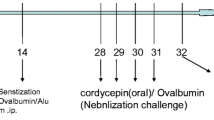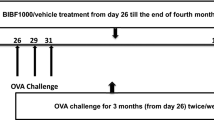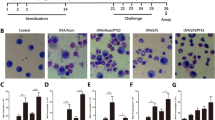Abstract
Objective
Blockage of nerve growth factor (NGF) by anti-NGF antibodies can inhibit allergic airway hyper-responsiveness in mice. This study was aimed at determining the mechanisms underlying the action of anti-NGF in vivo.
Methods
BALB/c mice were sensitized with ovalbumin (OVA) and treated with anti-NGF. At 1 day after the last challenge, their airway responsiveness and inflammation were examined and the levels of cytokine and transcription factor mRNA transcripts in the lungs and cytokines in the bronchoalveolar lavage fluid were determined. The frequency of different functional T cells and the levels of serum OVA-specific antibodies were measured.
Results
OVA challenge induced severe airway resistance, inflammation, higher levels of IL-4, TNFα, IL-17A, TGFβ, GATA-3 and RORγT expression and increased Th2 and Th17 cells and IgE responses, but decreased IFNγ and IL-10 responses, T-bet and Foxp3 expression and Th1 and Tregs. Treatment with anti-NGF significantly reduced allergic airway resistance and inflammation, up-regulated IFNγ, IL-10, TGFβ, T-bet, and Foxp3 expression, increased Th1 and Tregs, but down-regulated IL-4, TNFα, IL-17A, RORγT and GATA-3 expression and reduced Th2 and Th17 cells, accompanied by increased serum IgG2a.
Conclusions
Anti-NGF inhibits allergic airway inflammation by modulating the balance of pro- and anti-asthmatic T cell responses in the lungs of mice.





Similar content being viewed by others
Abbreviations
- AHR:
-
Airway hyperresponsiveness
- APC:
-
Antigen presenting cells
- BALF:
-
Bronchoalveolar lavage fluid
- H&E:
-
Hematoxylin and eosin
- HRP:
-
Horseradish peroxidase
- NGF:
-
Nerve growth factor
- OVA:
-
Ovalbumin
- TMB:
-
Tetramethylbenzidine
- WBC:
-
White blood cells
References
Holgate ST, Arshad HS, Roberts GC, Howarth PH, Thurner P, Davies DE. A new look at the pathogenesis of asthma. Clin Sci (Lond). 2009;118:439–50.
Westergren-Thorsson G, Larsen K, Nihlberg K, Andersson-Sjoland A, Hallgren O, Marko-Varga G, et al. Pathological airway remodelling in inflammation. Clin Respir J. 2010;4(Suppl 1):1–8.
Malik G, Tagiyeva N, Aucott L, McNeill G, Turner SW. Changing trends in asthma in 9–12 year olds between 1964 and 2009. Arch Dis Child. 2010;96:227–31.
Henneberger PK, Redlich CA, Callahan DB, Harber P, Lemiere C, Martin J, et al. An official American thoracic society statement: work-exacerbated asthma. Am J Respir Crit Care Med. 2011;184:368–78.
Dong L, Chen M, Zhang Q, Li LZ, Xu XQ, Xiao W. T-bet/GATA-3 ratio is a surrogate measure of Th1/Th2 cytokine profiles and may be novel targets for CpG ODN treatment in asthma patients. Chin Med J (Engl). 2006;119:1396–9.
Josefowicz SZ, Rudensky A. Control of regulatory T cell lineage commitment and maintenance. Immunity. 2009;30:616–25.
Kawaguchi M, Kokubu F, Fujita J, Huang SK, Hizawa N. Role of interleukin-17F in asthma. Inflamm Allergy Drug Targets. 2009;8:383–9.
Robinson DS. Regulatory T cells and asthma. Clin Exp Allergy. 2009;39:1314–23.
Commins SP, Borish L, Steinke JW. Immunologic messenger molecules: cytokines, interferons, and chemokines. J Allergy Clin Immunol. 2009;125:S53–72.
Wakashin H, Hirose K, Maezawa Y, Kagami S, Suto A, Watanabe N, et al. IL-23 and Th17 cells enhance Th2-cell-mediated eosinophilic airway inflammation in mice. Am J Respir Crit Care Med. 2008;178:1023–32.
Monteseirin J. Neutrophils and asthma. J Investig Allergol Clin Immunol. 2009;19:340–54.
Ohkawara Y, Lei XF, Stampfli MR, Marshall JS, Xing Z, Jordana M. Cytokine and eosinophil responses in the lung, peripheral blood, and bone marrow compartments in a murine model of allergen-induced airways inflammation. Am J Respir Cell Mol Biol. 1997;16:510–20.
Ishiura Y, Fujimura M, Nobata K, Myou S, Oribe Y, Abo M, et al. Th2 cytokine inhibition and cough in asthmatic and bronchitic patients. Ann Med. 2004;36:623–9.
Park SW, Jangm HK, An MH, Min JW, Jang AS, Lee JH, et al. Interleukin-13 and interleukin-5 in induced sputum of eosinophilic bronchitis: comparison with asthma. Chest. 2005;128:1921–7.
Wilson RH, Whitehead GS, Nakano H, Free ME, Kolls JK, Cook DN. Allergic sensitization through the airway primes Th17-dependent neutrophilia and airway hyperresponsiveness. Am J Respir Crit Care Med. 2009;180:720–30.
Truyen E, Coteur L, Dilissen E, Overbergh L, Dupont LJ, Ceuppens JL, et al. Evaluation of airway inflammation by quantitative Th1/Th2 cytokine mRNA measurement in sputum of asthma patients. Thorax. 2006;61:202–8.
Matsumoto K, Inoue H, Fukuyama S, Kan OK, Eguchi-Tsuda M, Matsumoto T, et al. Frequency of Foxp3+ CD4CD25+ T cells is associated with the phenotypes of allergic asthma. Respirology. 2009;14:187–94.
Akdis M, Akdis CA. Mechanisms of allergen-specific immunotherapy. J Allergy Clin Immunol. 2007;119:780–91.
Arredondo LR, Deng C, Ratts RB, Lovett-Racke AE, Holtzman DM, Racke MK. Role of nerve growth factor in experimental autoimmune encephalomyelitis. Eur J Immunol. 2001;31:625–33.
Braun A, Appel E, Baruch R, Herz U, Botchkarev V, Paus R, et al. Role of nerve growth factor in a mouse model of allergic airway inflammation and asthma. Eur J Immunol. 1998;28:3240–51.
Abram M, Wegmann M, Fokuhl V, Sonar S, Luger EO, Kerzel S, et al. Nerve growth factor and neurotrophin-3 mediate survival of pulmonary plasma cells during the allergic airway inflammation. J Immunol. 2009;182:4705–12.
Noga O, Peiser M, Altenahr M, Schmeck B, Wanner R, Dinh QT, et al. Selective induction of nerve growth factor and brain-derived neurotrophic factor by LPS and allergen in dendritic cells. Clin Exp Allergy. 2008;38:473–9.
Scuri M, Samsell L, Piedimonte G. The role of neurotrophins in inflammation and allergy. Inflamm Allergy Drug Targets. 2010;9:173–80.
Bonini S, Lambiase A, Bonini S, Angelucci F, Magrini L, Manni L, et al. Circulating nerve growth factor levels are increased in humans with allergic diseases and asthma. Proc Natl Acad Sci USA. 1996;93:10955–60.
De Vries A, Engels F, Henricks PA, Leusink-Muis T, Fischer A, Nijkamp FP. Antibodies directed against nerve growth factor inhibit the acute bronchoconstriction due to allergen challenge in guinea-pigs. Clin Exp Allergy. 2002;32:325–8.
Glaab T, Hoymann HG, Hecht M, Korolewitz R, Tschernig T, Hohlfeld JM, et al. Effect of anti-nerve growth factor on early and late airway responses in allergic rats. Allergy. 2003;58:900–4.
Lee CC, Huang HY, Chiang BL. Lentiviral-mediated GATA-3 RNAi decreases allergic airway inflammation and hyperresponsiveness. Mol Ther. 2008;16:60–5.
Myou S, Leff AR, Myo S, Boetticher E, Tong J, Meliton AY, et al. Blockade of inflammation and airway hyperresponsiveness in immune-sensitized mice by dominant-negative phosphoinositide 3-kinase-TAT. J Exp Med. 2003;198:1573–82.
Snijders D, Agostini S, Bertuola F, Panizzolo C, Baraldo S, Turato G, et al. Markers of eosinophilic and neutrophilic inflammation in bronchoalveolar lavage of asthmatic and atopic children. Allergy. 2009;65:978–85.
Finotto S. T-cell regulation in asthmatic diseases. Chem Immunol Allergy. 2008;94:83–92.
Callard RE, Turner MW. Cytokines and Ig switching: evolutionary divergence between mice and humans. Immunol Today. 1990;11:200–3.
Rosenwasser LJ. Mechanisms of IgE inflammation. Curr Allergy Asthma Rep. 2011;11:178–83.
D’Alessio FR, Tsushima K, Aggarwal NR, West EE, Willett MH, Britos MF, et al. CD4+ CD25+ Foxp3+ Tregs resolve experimental lung injury in mice and are present in humans with acute lung injury. J Clin Invest. 2009;119:2898–913.
Freund-Michel V, Frossard N. The nerve growth factor and its receptors in airway inflammatory diseases. Pharmacol Ther. 2008;117:52–76.
Aloe L, Probert L, Kollias G, Micera A, Tirassa P. Effect of NGF antibodies on mast cell distribution, histamine and substance P levels in the knee joint of TNF-arthritic transgenic mice. Rheumatol Int. 1995;14:249–52.
Cazzola M, Polosa R. Anti-TNF-alpha and Th1 cytokine-directed therapies for the treatment of asthma. Curr Opin Allergy Clin Immunol. 2006;6:43–50.
Ahangarani RR, Janssens W, VanderElst L, Carlier V, VandenDriessche T, Chuah M, et al. In vivo induction of type 1-like regulatory T cells using genetically modified B cells confers long-term IL-10-dependent antigen-specific unresponsiveness. J Immunol. 2009;183:8232–43.
Yang M, Kumar RK, Foster PS. Interferon-gamma and pulmonary macrophages contribute to the mechanisms underlying prolonged airway hyperresponsiveness. Clin Exp Allergy. 2009;40:163–73.
Ehrhard PB, Erb P, Graumann U, Otten U. Expression of nerve growth factor and nerve growth factor receptor tyrosine kinase Trk in activated CD4-positive T-cell clones. Proc Natl Acad Sci USA. 1993;90:10984–8.
Noga O, Peiser M, Altenahr M, Knieling H, Wanner R, Hanf G, et al. Differential activation of dendritic cells by nerve growth factor and brain-derived neurotrophic factor. Clin Exp Allergy. 2007;37:1701–8.
Sato K, Yamashita N, Baba M, Matsuyama T. Modified myeloid dendritic cells act as regulatory dendritic cells to induce anergic and regulatory T cells. Blood. 2003;101:3581–9.
Aloe L, Tuveri MA. Nerve growth factor and autoimmune rheumatic diseases. Clin Exp Rheumatol. 1997;15:433–8.
Raychaudhuri SP, Sanyal M, Weltman H, Kundu-Raychaudhuri S. K252a, a high-affinity nerve growth factor receptor blocker, improves psoriasis: an in vivo study using the severe combined immunodeficient mouse-human skin model. J Invest Dermatol. 2004;122:812–9.
Conflict of interest
All of the authors state no conflicts of interest.
Author information
Authors and Affiliations
Corresponding author
Additional information
Responsible Editor: Michael Parnham.
Rights and permissions
About this article
Cite this article
Shi, Y., Jin, Y., Guo, W. et al. Blockage of nerve growth factor modulates T cell responses and inhibits allergic inflammation in a mouse model of asthma. Inflamm. Res. 61, 1369–1378 (2012). https://doi.org/10.1007/s00011-012-0538-3
Received:
Revised:
Accepted:
Published:
Issue Date:
DOI: https://doi.org/10.1007/s00011-012-0538-3




